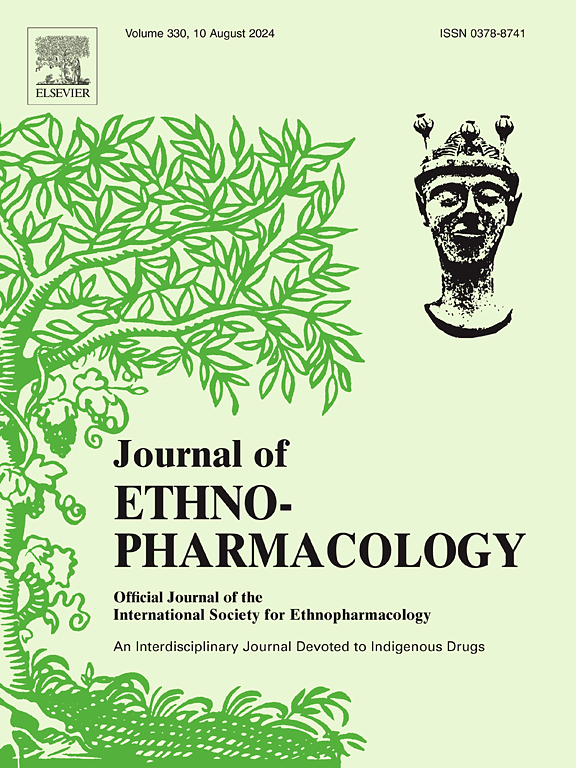Chuanxiong-Danggui herb pair alleviated cognitive deficits of APP/PS1 mice by promoting mitophagy
IF 4.8
2区 医学
Q1 CHEMISTRY, MEDICINAL
引用次数: 0
Abstract
Ethnopharmacological relevance
Disruption of receptor-mediated mitophagy contributes to neuronal damage in Alzheimer's disease (AD). Chuanxiong-Danggui herb pair (CDHP) is classic herbal pair applied to treating neurodegenerative diseases including AD, Amyotrophic Lateral Sclerosis, Parkinson's disease. Though studies have demonstrated the neuroprotective effects of CDHP, the underlying mechanisms by which CDHP attenuates neuronal impairment of AD remains to be elucidated.
Aim of the study
The objective of this work was to investigate the anti-AD mechanism of CDHP in APP/PS1 mice.
Materials and methods
Behavioral assessments were conducted on C57BL/6J and APP/PS1 mice following CDHP treatment, alongside an evaluation of neuronal morphology in the hippocampal region. In vitro, HT-22 cells were induced by Aβ25-35 before being treated with CDHP. The mechanisms of CDHP were investigated using transmission electron microscopy, Golgi staining, immunofluorescence, and Western blot analysis.
Results
Results from the passive avoidance test and the Morris water maze (MWM) indicated that CDHP significantly mitigated cognitive deficits of APP/PS1 mice, accompanied by a reduction of pathological damage in the CA1 and CA3 regions of hippocampus. Further testing found that a significant reduction in dendritic spines density was rescued by CDHP. Synaptophysin (SYN) and postsynaptic density protein 95 (PSD-95) were elevated in the CDHP group, while β-amyloid (Aβ) plaques deposition was significantly reduced. Simultaneously, CDHP markedly inhibited neuronal apoptosis through a decrease of the levels of Cleaved Caspase-12 and enhanced expression of Bcl-2/Bax, both in vivo and in vitro. Additionally, CDHP improved mitochondrial morphology and function in the AD model by decreasing abnormal mitochondria and increasing the expression of COXIV. Transmission electron microscopy (TEM) revealed that clear mitophagy-autophagosomes were nearly absent in APP/PS1 mice, while the expression of p62 and LC3B were elevated following CDHP treatment. Furthermore, CDHP increased the expression of the FUNDC1 and PGAM5 in APP/PS1 mice and AD-like cell models.
Conclusion
These findings suggest that CDHP mitigated cognitive dysfunction in APP/PS1 mice by enhancing mitophagy to reduce neuronal injury.
川芎当归对通过促进线粒体自噬减轻APP/PS1小鼠的认知缺陷。
民族药理学相关性:受体介导的线粒体自噬破坏有助于阿尔茨海默病(AD)的神经元损伤。川芎当归是治疗AD、肌萎缩性侧索硬化症、帕金森病等神经退行性疾病的经典中药对。虽然研究已经证明了CDHP的神经保护作用,但CDHP减轻阿尔茨海默病神经元损伤的潜在机制仍有待阐明。研究目的:探讨CDHP对APP/PS1小鼠抗ad的作用机制。材料与方法:对CDHP处理后的C57BL/6J和APP/PS1小鼠进行行为学评价,并对海马区神经元形态进行评价。体外用a - β25-35诱导HT-22细胞,然后用CDHP处理。采用透射电镜、高尔基染色、免疫荧光、siRNA和Western blot分析CDHP的作用机制。结果:被动回避实验和Morris水迷宫(MWM)结果显示,CDHP显著减轻APP/PS1小鼠的认知缺陷,同时减轻海马CA1和CA3区的病理损伤。进一步的测试发现,CDHP可以显著减少树突棘密度。CDHP组突触素(SYN)和突触后密度蛋白95 (PSD-95)升高,β-淀粉样蛋白斑块沉积明显减少。同时,在体内和体外实验中,CDHP通过降低Cleaved Caspase-12水平和增强Bcl-2/Bax表达,显著抑制神经元凋亡。此外,CDHP通过减少异常线粒体和增加COXIV的表达,改善了AD模型中的线粒体形态和功能。透射电镜(TEM)显示APP/PS1小鼠几乎没有清晰的自噬体,而CDHP处理后p62和LC3B的表达升高。此外,CDHP增加了APP/PS1小鼠和ad样细胞模型中FUNDC1和PGAM5的表达。结论:CDHP通过增强线粒体自噬来减轻APP/PS1小鼠的认知功能障碍,从而减轻神经元损伤。
本文章由计算机程序翻译,如有差异,请以英文原文为准。
求助全文
约1分钟内获得全文
求助全文
来源期刊

Journal of ethnopharmacology
医学-全科医学与补充医学
CiteScore
10.30
自引率
5.60%
发文量
967
审稿时长
77 days
期刊介绍:
The Journal of Ethnopharmacology is dedicated to the exchange of information and understandings about people''s use of plants, fungi, animals, microorganisms and minerals and their biological and pharmacological effects based on the principles established through international conventions. Early people confronted with illness and disease, discovered a wealth of useful therapeutic agents in the plant and animal kingdoms. The empirical knowledge of these medicinal substances and their toxic potential was passed on by oral tradition and sometimes recorded in herbals and other texts on materia medica. Many valuable drugs of today (e.g., atropine, ephedrine, tubocurarine, digoxin, reserpine) came into use through the study of indigenous remedies. Chemists continue to use plant-derived drugs (e.g., morphine, taxol, physostigmine, quinidine, emetine) as prototypes in their attempts to develop more effective and less toxic medicinals.
 求助内容:
求助内容: 应助结果提醒方式:
应助结果提醒方式:


